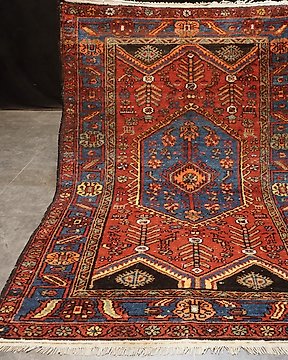
Hamadan Iran - Matta - 207 cm - 140 cm
Nr 82183405

Nr 82183405

AFG Koliai with goat wool
Knot density: 200.000 knots/sqm
Pattern: Koliai Medallion
Condition New
Material: pile 100% wool - warp 100% goat wool (very rare material)
Koliai carpet
The Koliai (also: Koliay, Kolyay, Q(u)liay) is a oriental carpet from Persian Kurdistan and thus a peasant weave of the Kurds in western Persia. The Kurds used to live in Kordestāns as nomads, but they have now settled down. They live from farming and animal husbandry. The collective term Koliai encompasses very different carpets made by the regional rural population, particularly those living in the western provinces of Kordestan, Zanjan and Kermānschāh. What they have in common is that they are knotted in a high-pile and full volume. Their patterns often consist of geometric figures in muted colors. Patterns with small diagonal diamonds are also common.
origin of Koliai carpets
Koliais are Persian tribal rugs made by Kurdish nomadic peoples in western Iran getting produced. They often stand out for the bright and vibrant colors they use. These rugs were not originally made for commercial sale. Rather, the women who knotted them followed an ancient custom that provided tribal families with handwoven items of practical value such as floor coverings, blankets, storage bags, saddlecloths, and financial security in case of future hardships. The Koliai rugs are a truly beautiful and colorful collection that will enhance a room for years to come.
History of the Koliai carpets
Kurdish rugs are knotted throughout western Iran, in and around the rugged mountainous region of Kurdistan. The Kurds descend from the ancient nomadic peoples who roamed the area thousands of years ago. They lead a semi-nomadic life, either in villages or in roving tribes away from the cities, where they can still maintain their ancient traditions and live as they did thousands of years ago.
Some of the Kurdish tribes in the western regions are the Herki, Senjabi, Gurani, Jaffid and Kalhors. Some important centers of Kurdish carpet production are Senneh, Bijar and the district of Khamseh. Other Kurdish villages and districts producing carpets are Borchelu, Goltogh, Khoi, Koliai, Lylyan, Mousel, Nanadj, Songhore, Touserkan and Zagheh.
As you can see, the Kurds are an ancient semi-nomadic and/or nomadic people of Iran whose history dates back thousands of years. Many other important centers of carpet production in Iran, such as Hamadan, Lorestan or even Arrack, show clear traces of Kurdish influence. Sometimes the style and techniques of Iran's also widespread Turkish population are also adopted. The Kurds are a very peaceful and gentle group who prefer their simple nomadic life to the complexities and frustrations of the modern technological world.
Characteristics of the Koliai carpets
material and knotting
Kurdish rugs, like all other Persian rugs, are 100% handmade. They are made from pure wool spun from the weaver's own sheep. On very rare occasions, a rug's pile may contain silk, and often the basis of a Kurdish rug is goat hair. However, the pile is always made of wool. The knot quality of Kurdish carpets varies between loose and dense knots, with the Persian asymmetrical knot being used more frequently than the Turkish symmetrical one.
Color
The colors are mainly achieved with natural vegetable dyes. The coloring of most Kurdish carpets is light and bright. Unlike most people in the western world who like faded and muted colors, Kurds love bright and vibrant colors. These exciting rugs bring life to the dreary homes of these common people. All Kurdish rugs are strong and durable as they have been proven for thousands of years.
design and pattern
The Koliai often has a large central medallion with a classic Herati hexagonal diamond design and beveled corners within the main border.
Quality of Koliai carpets
The design is robust. The heavy, compact carpets are wear-resistant. The classic sizes are 150-160 x 300-330 cm. These are carpets that are quite narrow in relation to their length. Mainly the symmetrical or Turkish knot is used. The base fabrics of wool are still used as a base. Older Koliai rugs are usually knotted on a wool warp, while younger ones are knotted on a cotton warp. Both have two weft threads between the rows of knots.
Manufacturers often use – unconsciously eclectic – patterns from other provenances outside of their own region. However, their imitations acquire a character of their own, especially in relation to the coloring, which regularly appears very saturated.
Koliai rugs are also known by the name Songhur. In addition, there are Bijar and Senneh carpets.
“Errors and mistakes excepted”
Hur du köper på Catawiki
1. Upptäck något speciellt
2. Lägg det högsta budet
3. Gör en säker betalning